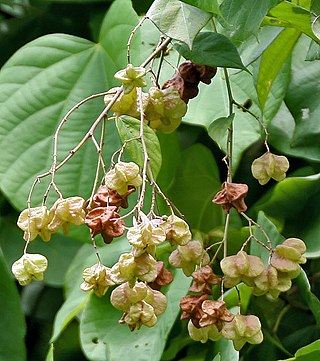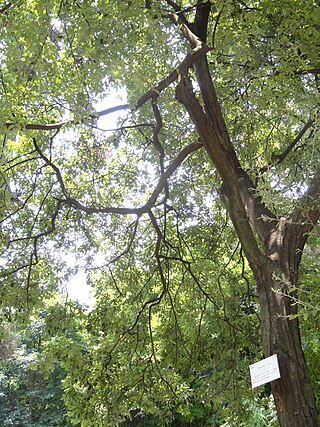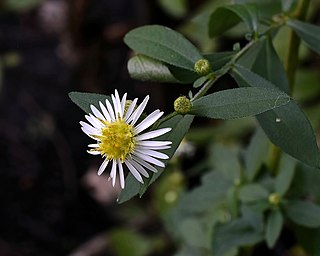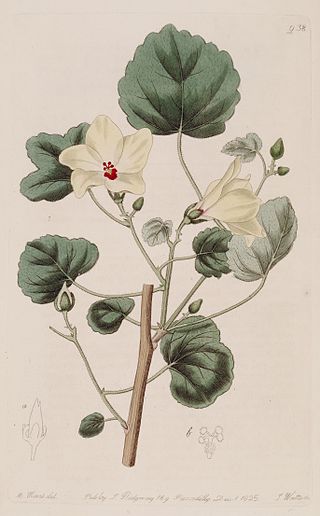Cycas calcicola is a species of cycad in the genus Cycas, native to northern Australia in the northwest of Northern Territory.
Cycas campestris is a species of cycad in the genus Cycas, native to southeastern Papua New Guinea in the lowland region near Port Moresby. It grows in open, grassy locations, often in areas with frequent grass fires.

Gossypium arboreum, commonly called tree cotton, is a species of cotton native to India, Pakistan and Bangladesh and other tropical and subtropical regions of the Old World. There is evidence of its cultivation as long ago as the Harappan civilization of the Indus Valley for the production of cotton textiles. The shrub was included in Linnaeus's Species Plantarum published in 1753. The holotype was also supplied by him, which is now in the Linnean Herbarium in the Swedish Museum of Natural History.

Kleinhovia hospita is an evergreen, tropical tree native to Indonesia, Malaysia and other parts of tropical Asia. It is monotypic, being the only species in the genus Kleinhovia.

Dichotomanthes is a monotypic genus of flowering plants belonging to the family Rosaceae. The sole species is Dichotomanthes tristaniaecarpa. The flower is perigynous the ovary is superior. The fruit of the plant is a dry achene.
Bulbophyllum xanthornis is a species of orchid in the genus Bulbophyllum.
Petenaea cordata was first described in Elaeocarpaceae and later placed in Tiliaceae, but most authors have been uncertain about its familial affinities. It was considered a taxon incertae sedis in the Angiosperm Phylogeny Group classification. Molecular analyses based on a recent collection from Guatemala indicate a distant, weakly supported sister-group relationship to the African genus Gerrardina. As no obvious synapomorphies exist for Gerrardina and Petenaea, the new monogeneric family Petenaeaceae was proposed. The polymorphic order Huerteales now comprises four small families: Dipentodontaceae, Gerrardinaceae, Petenaeaceae and Tapisciaceae. Petenaea cordata is the only species in the genus Petenaea.
Buddleja hatschbachii is a rare species found only in the wet ravines and rock slopes flanking the east side of the planalto of southern Brazil. The species was first described and named by Norman & Smith in 1976.
Buddleja acuminata is a rare shrub endemic to the northern half of Madagascar and eastern Zaire, where it grows along forest edges and in clearings at elevations of 50–800 m. The species was first named and described by Poiret in 1810.

Globularia salicina is a shrub native to the archipelago of Madeira and to the central and western Canary Islands.

Carlina salicifolia is a species of thistle found in Macaronesia.

Digitaria insularis is a species of grass commonly known as sourgrass. It is native to Central and South America and the southern parts of the United States and has been introduced into other parts of the world. It was first described by the German botanist Friedrich Karl Georg Fedde in 1904.

Brachylaena rotundata is an occasionally deciduous Southern African shrub or small tree growing to some 8m in height and of the family Asteraceae. It occurs in eastern Botswana, Transvaal, Mozambique, Zambia and Zimbabwe, growing in open woodland, on rocky koppies and slopes, and on stream banks. Kew accepts Brachylaena rotundata S. Moore as a species while 'Flora of Mozambique' treats it as a variety of Brachylaena discolor DC. It bears attractive foliage, green on the upper surface and silver-grey on the lower, leaves turning slightly reddish in autumn.
Leaves with petioles from 2 mm to 7 mm. long, lamina 4–15 x 2.5–6 cm., larger on coppice shoots, broadly oblanceolate or elliptic, obtuse to rounded at the apex, cuneate or rounded base, entire, occasionally coarsely dentate near the apex; upper surface araneous when young, or glabrescent; lower surface greyish tomentellous with prominent veins. Capitula sometimes preceding the leaves, young synflorescences with buds in axillary and terminal spikes, mature synflorescences with numerous capitula in dense terminal panicles 4–40 cm. long, or in short raceme-like panicles in axils of old leaves. Involucres cyathiform to obconic. Phyllaries minutely glandular outside, subobtuse, margins ciliolate, the outer phyllaries from c. 1 mm. long and ovate, the inner to c. 5 mm. long becoming lorate-lanceolate, narrowly obtuse or blunt at the apex; the outermost 5–8 series decreasing in size and extending down to the base of the capitulum stalk. Male flowers: corollas dull-yellow, 3–5 mm. long, lobes c. 1.5 mm. long and ± recurved; pappus uniseriate, setae 3–4 mm. long, subplumose, the seta barbs exceeding the seta axis in width. Female flowers: corollas dull-yellow, 3–5 mm. long, filiform, lobes erect up to c. 0.5 mm. long; achenes c. 4 mm. long, subcylindric-fusiform, narrowly c. 8-ribbed, pubescent; pappus 2-several-seriate, setae 4–5 mm. long, ± terete or flattened, seta barbs ± equalling the seta axis in width.""

Passiflora bogotensis is a climbing plant native to Colombia, in the genus Passiflora. It can also be found in Venezuela.

Symphyotrichum ontarionis is a species of flowering plant in the family Asteraceae native to eastern North America. Commonly known as Ontario aster and bottomland aster, it is a perennial, herbaceous plant that may reach heights of 120 centimeters. Each flower head has many tiny florets put together into what appear as one.

Thymus camphoratus is a species of flowering plant in the mint family Lamiaceae, endemic to southwest Portugal.
Gutenbergia rueppellii is an African species of flowering plant in the family Asteraceae.

Verbesina centroboyacana is a species of shrub in the family Asteraceae endemic to Colombia.

Gazania rigida, the "Karoo Gazania", is a species of flower native to the Western Cape and Northern Cape Provinces of South Africa.

Abelmoschus hostilis is a rare species of flowering plant in the Malvaceae family. It is native to Bangladesh and Myanmar and is known as "Kantabhendi" in Bengali.













